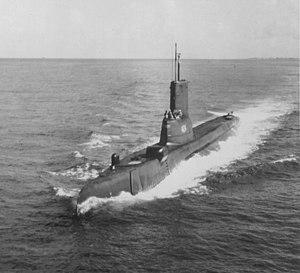USS Quillback (SS-424)
 |
|
| History | |
|---|---|
| Builder: | Portsmouth Naval Shipyard, Kittery, Maine |
| Laid down: | 27 June 1944 |
| Launched: | 1 October 1944 |
| Commissioned: | 29 December 1944 |
| Decommissioned: | April 1952 |
| Recommissioned: | 27 February 1953 |
| Decommissioned: | 23 March 1973 |
| Struck: | 23 March 1973 |
| Fate: | Sold for scrap, 21 March 1974 |
| General characteristics | |
| Class and type: | Tench-class diesel-electric submarine |
| Displacement: | |
| Length: | 311 ft 8 in (95.00 m) |
| Beam: | 27 ft 4 in (8.33 m) |
| Draft: | 17 ft (5.2 m) maximum |
| Propulsion: |
|
| Speed: |
|
| Range: | 11,000 nautical miles (20,000 km) surfaced at 10 knots (19 km/h) |
| Endurance: |
|
| Test depth: | 400 ft (120 m) |
| Complement: | 10 officers, 71 enlisted |
| Armament: |
|
| General characteristics (Guppy II) | |
| Displacement: |
|
| Length: | 307 ft (93.6 m) |
| Beam: | 27 ft 4 in (7.4 m) |
| Draft: | 17 ft (5.2 m) |
| Propulsion: | |
| Speed: |
|
| Range: | 15,000 nm (28,000 km) surfaced at 11 knots (20 km/h) |
| Endurance: | 48 hours at 4 knots (7 km/h) submerged |
| Complement: |
|
| Sensors and processing systems: |
|
| Armament: |
|
USS Quillback (SS-424), a Tench-class submarine, was the only ship of the United States Navy to be named for quillback, a fish of the sucker family, widespread in the freshwaters of North America and Northern Asia.
When her construction by the Portsmouth Navy Yard in Kittery, Maine, was authorized, her name was to be Trembler, which would have made her the first ship named for the trembler, a torpedinoid fish of the West Indies and Brazil, but she was given a less embarrassing name on 7 December 1943.
Her keel was laid down on 27 June 1944. She was launched on 1 October 1944 sponsored by Mrs. J. A. Tyree, Jr., and commissioned on 29 December 1944 with Lieutenant Commander R. P. Nicholson in command.
After training at New London, Connecticut, and work on an experimental ordnance project at Key West, Florida, Quillback departed for Pearl Harbor and her maiden war patrol, off the coast of Kyūshū. During this patrol, from 30 May to 24 July 1945, she destroyed a Japanese suicide motorboat and rescued one aviator from the water only a half mile from the heavily armed shore. Surrender of the enemy found Quillback refitting for her second patrol at Guam.
Peacetime duties returned Quillback to New London for duty as a unit of Submarine Squadron 2. From 1945 to 1951, she operated with the Submarine School in a training capacity and as an experimental unit of the Naval Underwater Sound Laboratory. In April 1951, Quillback departed New London for a six-month tour of duty with the Sixth Fleet in the Mediterranean Sea. In April 1952, she reported to the Portsmouth Naval Shipyard for decommissioning and conversion.
...
Wikipedia
